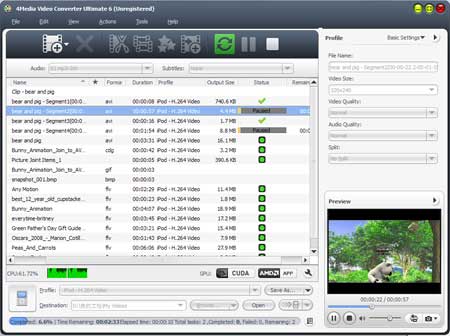Microsoft Video 1 Compressor
Microsoft Video 1 or MS-CRAM is an early lossy video compression and decompression algorithm that was released with version 1.0 of Microsoft's Video for Windows in November 1992. It is based on MotiVE, a vector quantization codec which Microsoft licensed from Media Vision. In 1993, Media Vision marketed the Pro Movie Spectrum, an ISA board that captured video in both raw and MSV1 formats. After searching for a converter that was free and not a limited trial version that would only convert 1/3 of my videos, I found prism. Its easy, its free. Its not fast, like at all, but it is free. It took 18+ hours to convert about 5 hours of video, but im ok with that. All the other converter progs out there wanted $40+ for a full version.
UnderstandingCompression in AVIEven with the advent ofpowerful processors,bigger hard-drives andpreviously unimaginableInternet speeds, theneed for datacompression can't beoverstated. Whiletext files and documentstake little space tostore and littlebandwidth to transmit;image, audio and videofiles are a differentball game altogether.Uncompressed data,especially video andaudio content, simplytakes up a lot of space.Compressed files take upless space, saving youmoney on additionalstorage and bandwidthcharges.

Compression can bebroadly classified intotwo types-. Lossless. LossyLosslessIn the lossless type ofcompression, no data islost during thecompression process.When the compressed fileis decompressed, theresult is identical tothe data beforecompression.Computer programs,software applications,databases etc. Arecompressed usinglossless techniques,since a change in evenone bit of data can makethem useless or produceincorrect results.For most files, losslessmethods reduce the filesize by only 50-60%.Well known losslesscompression methodsinclude Zip and RAR.
LossyLossy compressionreduces file size bypermanently eliminatingredundant information,so that only a part ofthe original data isretained and reproduced.Most video and audiocompressors compressdata in ways that arelossy, but produce veryhigh compression levels.Properly compressedvideo and audio filesare nearlyindistinguishable fromthe original to thehuman eye or ear.In audio compression, psychoacoustic techniques are used toremove non-audiblecomponents of the audiosignal. Lossycompression techniquesare known to producehigh compression.Uncompressed AVI filesare huge. AVIcodecs (COmpressor –DECompressor) greatlyreduce file sizes whilemaintaining optimumquality.(Generally, a codec is a program thatcompresses ordecompresses audio orvideo. There canbe severalcodecs—programs—that cancompress using the sametechnique.
Forinstance, there areseveral codecs thatimplement MPEG 4 videocompression.)AVI’s popularity andextensibility depend onthe fact that you canfreely select differentvideo and audio codecs.Other file formats likeMPEG 2 or WMV are not asflexible. UnlikeAVI, which is more of ageneral specification,MPEG 2 is a compressiontechnique itself.With MPEG, you do nothave the option ofsubstituting your owncodec. This makesit difficult to adoptMPEG to use newer andbetter compressiontechnologies. WithAVI, you can just switchto a better codec.The Windows Media format(WMV) also uses codecs,but fewer of them, andthe selection process ishidden from the user.You just have to selectan appropriate profileand the profile willautomatically select acodec. This makescreating a WMV file verysimple. Becausethe process of making anAVI file lets you chooseamong up to dozens ofdifferent codecs, youface the challenge ofselecting the rightcodec.Many AVI compressors,tailored for differentneeds, have beendesigned. Counter strike source kostenlos vollversion deutsch chip.
For ourpurpose, the key thingsto know are the qualityof the video playbackand the compressionratio for each codec.Which compressor tochoose depends on theintended use of the fileand the desired outputquality.
